The Covid-19 pandemic greatly impacted several industries — travelling was restricted, schools closed, masks introduced, and the fitness industry suffered a major blow. Reports indicated that big fitness brands stopped investing as the market was fast diminishing.
Australia’s gyms were all forced to close down in 2020. Insufferable pandemic restrictions and repeated shutdowns also characterised the following year (2021). The Australian health and fitness sector made significant progress toward recovery in 2022–2023.
The progress is because more individuals than ever in Australia are talking about their health and fitness.
In 2022, Australia’s health and industrial business sector brought in $292 million. According to a report by Statista, about 49.1 percent of Aussies (aged 18 to 24) used health clubs and gyms regularly.
With a growing health culture, the fitness business is anticipated to increase by 3.7% from 2019 through 2024. Because people are more conscious of their health, the fitness industry is expected to expand by 3.7 percent in five years; from 2019 to 2024.
Australian Market Size of Fitness and Gym Centers Stats
The fitness business has experienced exponential growth after 2022. Increased health awareness during the post-pandemic period saved the sector even if government funding and subsidies were no longer available.
Authorities forecast that the fitness business will continue to increase in 2023 after analysing the audience’s response, which helped save the industry. Here is a graph illustrating the participation in and completion of fitness programs over the previous five years.
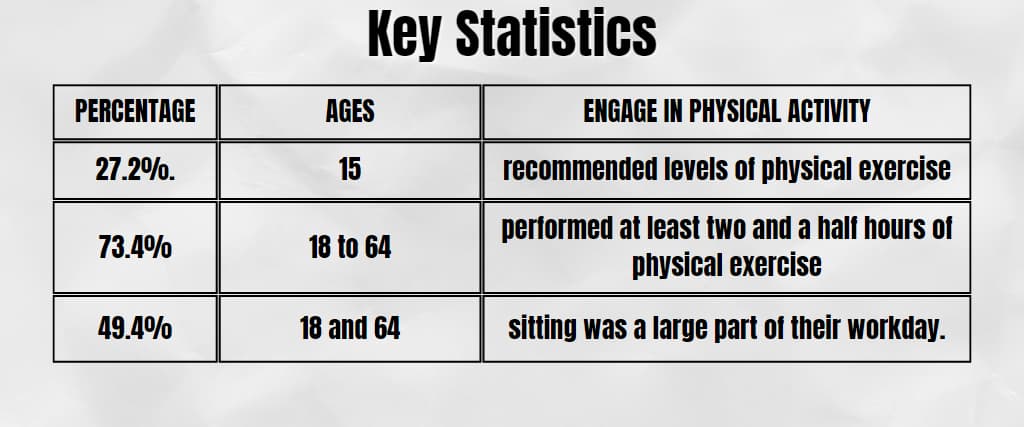
Key Statistics
- People over the age of 15 who met the recommended levels of physical exercise were 27.2%.
- In the previous week,73.4% of adults ages 18 to 64 performed at least two and a half hours of physical exercise.
- 49.4% of employed individuals between 18 and 64 reported that sitting was a large part of their workday.
You can engage in physical activity in various settings, such as your home, workplace, and other locations. Regular physical activity benefits health issues like stroke, heart disease, diabetes, and high blood pressure by preventing and managing them.
A healthy weight can be achieved and maintained with the help of physical exercise.
Physical Activity Recommendations
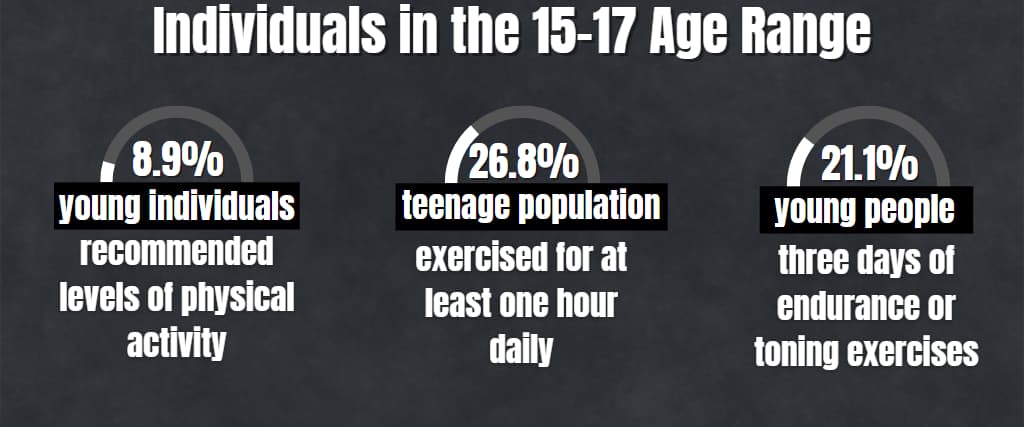
Individuals in the 15–17 Age Range
Teenagers between the ages of 15 and 17 should exercise for at least 60 minutes each day in a moderate-to-vigorous manner, according to the Physical Activity Guidelines, 2014.
The recommendations clarify that young people should exercise strength or toning, ideally three days a week.
8.9% of young individuals met the recommended levels of physical activity. 26.8% of the teenage population exercised for at least one hour daily. However, not all of it was vigorous or moderate.
Over a fifth (21.1%) of young people in the previous week engaged in at least three days of endurance or toning exercises.
Individuals in the 18 to 64-Year-Range
According to Physical Activity Guidelines, 2014, adults between 18 and 64 should exercise most days of the week. (interpreted as five active days in this survey).
Adults (18-64) should follow the guidelines and perform 150-300 minutes of moderate-intensity activity, 75-150 minutes of strenuous exercise per week, or a similar combination of both.
The guidelines advise those between 18 and 64 to incorporate endurance or toning exercises for at least two weekly days.
24.5% of adults between 18 and 64 reached the recommended levels of physical exercise. When taking into account the guidelines’ prescriptions for those between the ages of 18 and 64:
Nearly 59.1%of people exercised for at least 30 minutes five days a week. 28.2% engaged in strength or toning activities twice a week or more.
Men were more inclined than women to reach the recommended levels of physical exercise (27.0% vs. 22.3%).
Although 75.5% of adults between the ages of 18 and 64 do not meet the guidelines:
- Two out of three individuals (69.7%) said they had exercised physically six or more days during the week preceding the interview.
- 73.4 per cent exercised for a minimum of 150 minutes in the week before the interview.
The sheer amount of sportswear on Sydney’s streets should be proof enough that inhabitants within the Harbour City are obsessed with staying in shape.
We’ve chosen the top gyms in Sydney to get in on the fitness trend, whether you’re searching for high-intensity exercise at any gym within the Sydney CBD (city centre), a welcoming, including a club in Potts Point, or pole dance lessons in the suburbs.
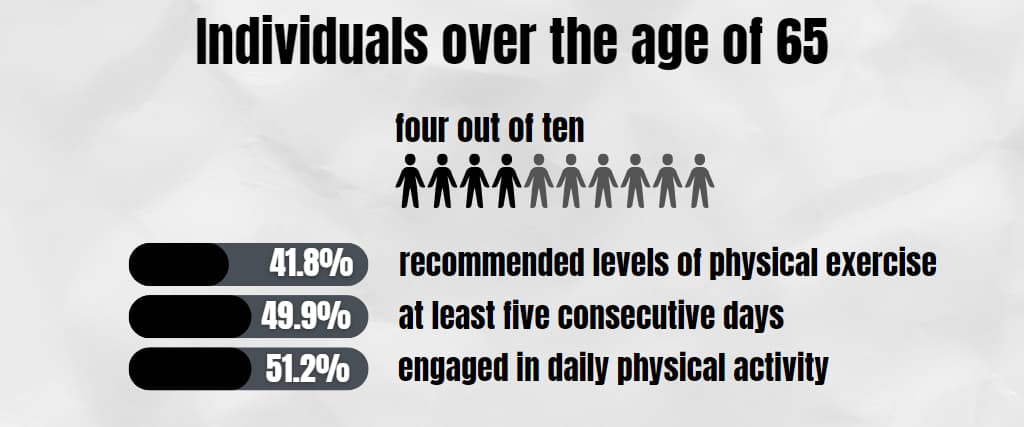
Individuals over the age of 65
The Physical Activity Guidelines, 2014, for people 65 and older, suggest engaging in physical exercise for at least 30 minutes most days, ideally daily.
Nearly four out of ten (41.8%) adults 65 and older in 2020–21 met the recommended levels of physical exercise. A similar percentage (51.2%) engaged in daily physical activity, and a half (49.9%) were involved in a minimum of a half hour of workouts on at least five consecutive days.
Population Traits and Physical Activity
The following characteristics were less prevalent among adults (18+) living in the most disadvantaged areas compared to those in less disadvantaged areas:
- Participated in physical activity of some kind in the previous week (78.3% as opposed to 92.1%)
- Met the recommended levels of physical activity (24.0% versus 34.4%).
The percentage of adults over 18 who met the requirements was the same in Remote Australia and Outer Regional (28.5%), Inner Regions of Australia (26.8%), and the major towns of Australia (28.3%).
A higher percentage of adults (18+) residing in Inner Regions of Australia than in Major Cities (17.4% vs.12.3%) reported doing no exercise in the previous week.
Compared to those who have earned a bachelor’s degree or above, those over 18 who have completed Year 10 or less in education are less likely to have exercised in the preceding week (74.7% vs.
Disability was linked to a doubled increase in the odds that a person had not exercised the week prior (20.5% vs. 9.9%).

Exercise Style
In the week before the interview, 50.9% of adults aged 15 and over who weren’t engaged in work-related activities walked for exercise, sport or recreation. Males were less likely than females (52.7 vs. 49.0%) to walk for exercise.
35.7% of people over 15 participated in moderate physical activity, while 17.7% engaged in vigorous exercise.
A third (32.5%) of adults over 15 reported engaging in strength or toning workouts, while 46.0% said they walked to get about.
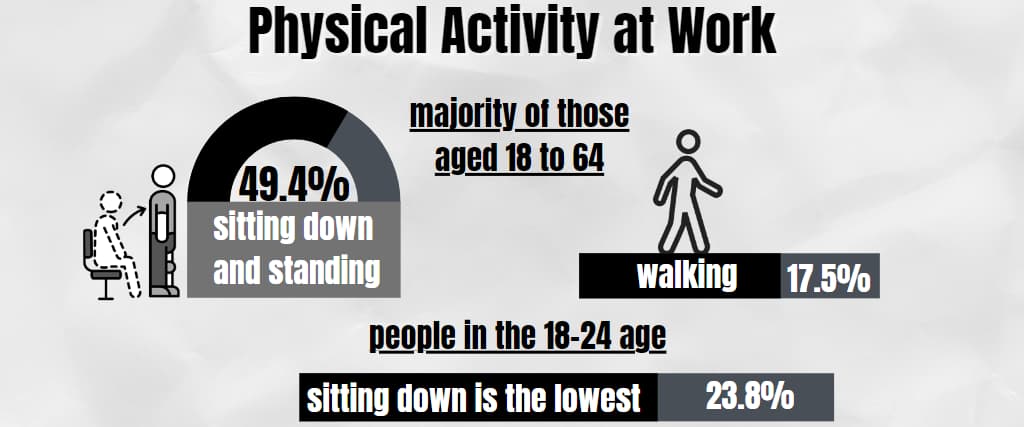
Physical Activity at Work
We asked those who had jobs and had worked the week before the interview to explain their typical weekday.
The majority of those aged 18 to 64 who had jobs and reported working in the previous week (49.4%) said they spent their days sitting down and standing (18.8%), and those walking (17.5%) were the subsequent most frequent activities.
The likelihood that people in the 18–24 age group spend most of their workday sitting down is the lowest (23.8%).
When reporting employment that required a lot of physical labour, males between the ages of 18 and 64 were four times more likely than women to do so (19.4% vs.
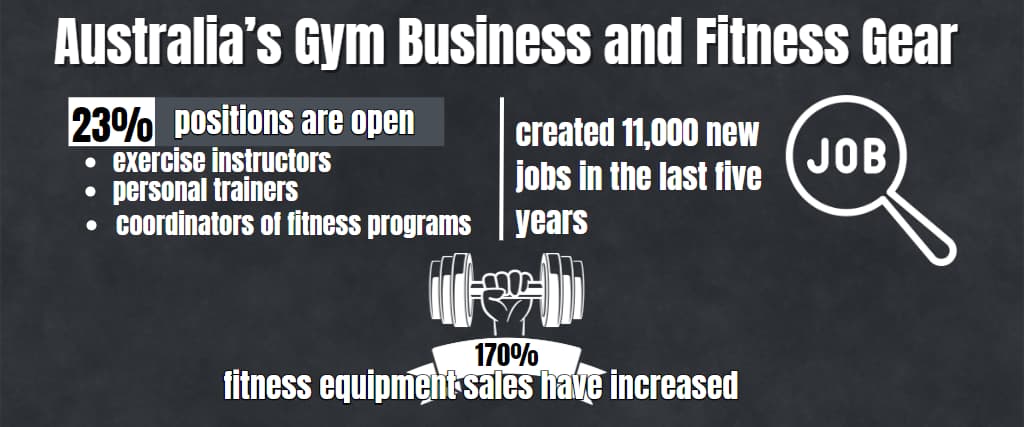
Australia’s Gym Business and Fitness Gear
The expansion of the fitness business has increased employment prospects in Australia’s fitness industry.
A survey indicates that about 23% more positions are open for group exercise instructors, personal trainers, coordinators of fitness programs, etc. Australians spent an estimated $8 billion on training and fitness gear in 2022.
In Australia, the fitness sector has created 11,000 new jobs in the last five years. Government officials are pushing relevant employees to import additional exercise equipment into Australia to keep up with the rapidly expanding fitness business.
According to estimates from the Australian fitness sector, fitness equipment sales have increased by 170% since the end of the pandemic.
Our selection of exciting and valuable products at Flex Fitness makes it simple to choose a functional trainer. In this category, our best offerings are:
Multi-Functional Machine Trainer F30 PRO
The F30 offers a one-stop shop for all your training needs, assisting with various exercises like deadlifts, squats, lunges, bench presses, cable crunches, chin-ups, and routines for toning the entire body.
With workouts that may be increased in intensity in strength and agility, this practical trailer will meet the fitness demands of most individuals, regardless of skill.
The functional trainer enables users to build strength in their major muscle groups while eliminating the necessity for various gym equipment for multiple workouts. This makes it ideal for smaller gyms looking to add value and workouts at home where space is limited.
The Functional trainer, Smith Machine, and Power Rack are all included in the F30 Functional Trainer, enabling use by both Standard and Olympic plates. Additionally, it is simple to clean and has storage room for two Olympic and two Standard sized barbells and separate weight plates.
Multi-Functional Trainer F40 PRO
Users of the Armortech F40 Functional Trainer can perform all the activities the functional trainer can perform, such as lunges, squats, wood chops, chin-ups, rows and shoulder presses.
The F40 model offers a Power Rack and a Smith Machine, similar to the F30 model, and adds a cable system to enable a range of training opportunities from a single machine.
This product is one of our most space-efficient alternatives, perfect for keeping your workout area small.
The F40 Trainer is excellent for achieving compound or solitary fitness goals and improving strength, power, and muscle endurance.
Functional Trainer F50 ELITE
The F50 ELITE offers a variety of training alternatives, including bridge curls, bench presses, deadlifts and lunges, just like other outstanding functional trainers.
It is ideal for attaining long-term fitness objectives with one convenient piece of equipment that simultaneously enables over 75 training routines. It is terrific for increasing endurance.
Ultimate Multi-Functional Trainer for the F70
The Armortech F70 Ultimate Multi-Functional Trainer delivers the same fantastic advantages as similar functional trainers, providing strength-building exercises that will increase muscle conditioning and tone, either a complete beginner’s workout or a more endured one.
Racking pins and unique linear bearing systems on both sides of the system ensures an excellent safety-conscious structure that enables an entire spectrum of natural movement to can be achieved. In addition, the product allows for smooth movements.
This trainer also has an unlimited lifetime warranty for your peace of mind.
F100 Infinity Functional Trainer by Armortech
With movements like shoulder presses, squats, cable step-ups, and many more made available by this excellent exercise equipment, you can meet all your fitness needs in one location.
The F100 is an ideal machine for people who want to be sure they’ve got everything required without having to pay for expensive upgrades in the future because it allows for new weights once you’ve achieved the set fitness goal.
What Does Australia’s Fitness Sector Have in Store for the Future?
Thanks to the burgeoning fitness sector, there couldn’t be a more suitable time for those looking to start careers as health and fitness professionals in Australia.
In addition to our recent record growth, fitness fanatics have never had more opportunities to pursue their passions.
The fitness sector grew significantly between 2014 to 2019 by 4.9%, and from 2020 to 2024, it is expected to expand by 3.7% annually.
Australians invest roughly $8.5 billion annually on fitness-related products and services, with the fitness sector alone bringing in $3 billion for the country’s economy.
The rise in the percentage of individuals working in fitness is the most significant trend we’ve observed in recent years. In Australia’s 6,426 fitness-related firms, 11,800 employment opportunities have been created in the last five years.
The future is promising as well; forecasts indicate that by 2024, there is projected to be a 16% growth in the number of jobs in the fitness industry.
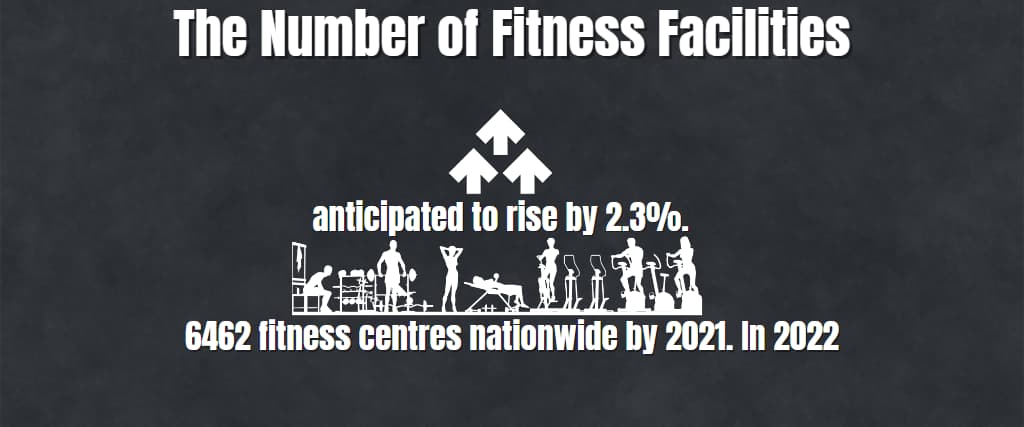
The Number of Fitness Facilities
Given the economic downturn and pandemic, available figures for Australia’s fitness industry are lower than usual. However, over the past several years, there has been an increase in the number of health clubs and fitness facilities.
According to figures for the fitness sector, there will be 6462 fitness centres nationwide by 2021. In 2022, that figure was anticipated to rise by 2.3%.
Conclusion
Influencers on social media and bloggers greatly increase Australians’ understanding of health and fitness. The above proof suggests that the Australian fitness sector statistics will continue to increase steadily over the coming years.
In Australia, the gym industry is crucial to the country’s economy.